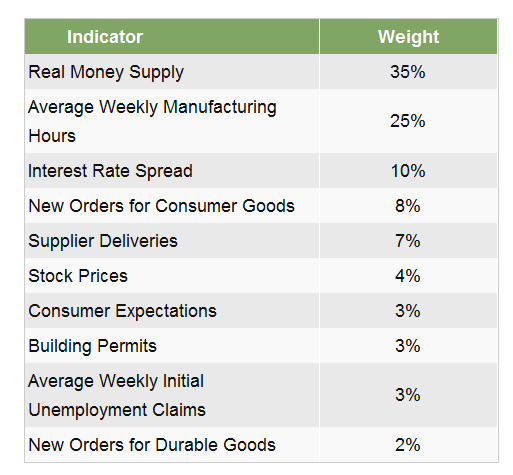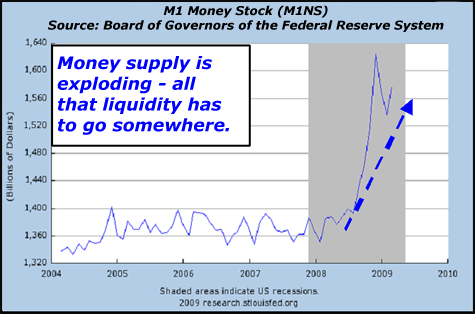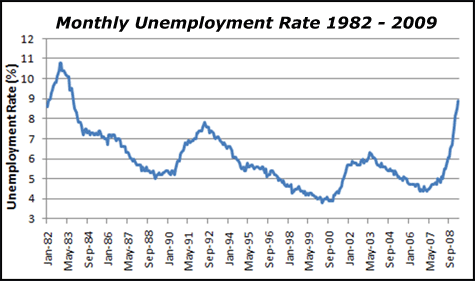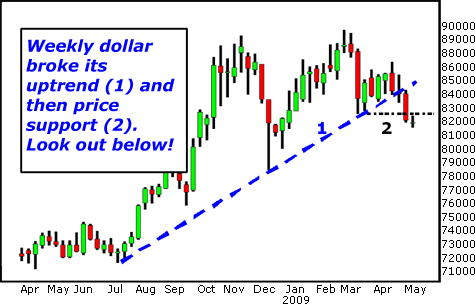How to Investors Can Profit as Leading Economic Indicators Turn Bullish
Stock-Markets / Investing 2009 May 17, 2009 - 05:35 PM GMTBy: Uncommon_Wisdom
 Sean Brodrick writes: The recent market rally has a lot of experts, analysts and investors scratching their heads. They ask: How can the market go up when dark storm clouds of failing banks, budget deficits and soaring unemployment hang over our economy?
Sean Brodrick writes: The recent market rally has a lot of experts, analysts and investors scratching their heads. They ask: How can the market go up when dark storm clouds of failing banks, budget deficits and soaring unemployment hang over our economy?
The answer is the difference between short-term and long-term outlooks. The good news is you can play the market either way.
First, the Good News
If you wonder what the optimists are looking at, it can be summed up as the Conference Board’s Index of Leading Economic Indicators. Here is a list of those indicators, with the weights given to each by the Conference Board …

Now for the shocker: Eight out of 10 of these leading economic indicators have now turned positive or at least neutral.
Let’s take a look at one of those components — real money supply …

As you can see, the Fed is flooding the system with money, and has been since shortly after the recession started (the recession is the gray area on the chart). All that money has to go somewhere, and in the short term, it’s helping prop up stock prices. It’s bullish for commodity prices as well.
Meanwhile, average manufacturing hours have turned up, as have supplier deliveries. Short-term rates have been lower than long-term rates for more than a year.
I don’t have to tell you that stocks have been in rally mode. In fact, the only two leading indicators that are still down are building permits (the housing market is still a disaster) and non-durable goods orders.
So, overall, the short-term picture is bright. And though we’ll see zigs and zags, it should continue to be bright as long as hot public money — paid for with your and my tax dollars — reinflates the rotted shell of the Ponzi economy.
That’s what I think we should call the last 8 or 10 years of an economy built on overdrawn consumer credit, balance sheets propped up with credit default swaps, and a banking system built on a foundation of lies.
Longer term, those chickens will come home to roost. The first indicator of long-term pain is this may be another jobless recovery.

While initial claims are starting to slow, continuing jobless claims are hitting all-time highs. The U.S. unemployment rate surged to 8.9 percent in April, the highest level since 1983. This is in fact, EXACTLY what you would expect to see in a jobless recovery!
But what about all those 5 million new green-collar jobs the Obama administration promised us? You know, the ones that are going to take America into the 21st Century.
Simple answer: Those jobs are going to India and China. Outsourcing is alive and well, and is hollowing out America’s “green jobs” future.
According to the 2009 Green Outsourcing Report, an annual industry study conducted by Brown-Wilson Group, green technology jobs are being created faster in India than in the United States, since Obama took office. U.S. corporations have offshored more than 22,000 new green-collar jobs to India alone.
So yes, the environmental movement IS creating demand for sustainability engineers, marketing and business development executives, data center management engineers, utilities and electric engineers and quality specialists … the problem is, the jobs are mostly in other countries.
It’s a fact that if a job can be can be done overseas for cheaper, a company is going to choose to outsource. And it’s not just green jobs. If anything, the recession has accelerated the offshoring of IT jobs as companies look for any way possible to cut costs.
Bottom line: In a recent Bloomberg survey, most economists projected that America’s jobless rate would stay above 8 percent through 2011.
When people don’t have jobs, they don’t spend money. Ours is a consumer-oriented society. So, in the longer-term, this will suck the wind out of a recovery.
Meanwhile, Washington is racking up huge debts as it tries to ease the pain of the recession, bails out the banks and props up the economy. This year, for the first time in living memory, receipts are lower than outlays in April, a whopping 34% lower than last year. The accumulated deficit for the first seven months of the fiscal year is almost double the entire total for last year.
And this week, the White House raised its estimate of the deficit this year to $1.84 trillion. That’s up 5 percent from the February estimate. Next year the deficit is expected to rise to $1.26 trillion — up 7.4 percent.
So how are Americans supposed to pay off all these towering debts if they don’t have jobs?
I think the Obama administration has already hit on the solution … and we’re seeing this plan in action.
Solution: Devalue the Dollar!
Recently, the U.S. dollar broke important price support. I put a daily chart of the U.S. dollar’s breakdown on my blog earlier this week. Now, take a look at this next chart, a weekly chart of the U.S. Dollar Index …

You can see that last month, the U.S. Dollar Index broke the uptrend it had enjoyed for more than a year. Then it broke down below price support. I think we’ll see the index test first 80, then maybe 77.70.
I think this fits in with the White House’s plan. If the dollar goes lower, the deflationary environment we’re in now should switch to inflation. That makes the big debts that were run up in old dollars easier to pay off.
At the same time, if the dollar falls vs. other currencies, U.S. labor will get cheaper compared to overseas labor. That keeps more jobs at home, and may even bring jobs offshored from Europe.
Sure, inflation will eat away at workers’ real income. But the White House is probably figuring that people would rather have a job that pays less than no job at all.
This trend will boost commodity prices, starting with oil and also includes gold, silver and base metals.
And that brings up ways you can profit from this move …
- Buy oil. The iPath Crude Oil ETN (OIL) and U.S. Oil Fund (USO) both track the price of oil.
- Buy gold. The SPDR Gold Shares (GLD) serve as a good proxy for gold, though I really prefer buying physical metal — just in case Obama’s efforts to reflate the bubble fail and the whole mess comes crashing down.
- Buy silver. The iShares Silver Trust (SLV) tracks silver, and should do very well as that metal goes higher.
These are unleveraged Exchange-Traded Funds (ETFs) and Exchange-Traded Notes (ETNs). There are also funds that are leveraged plays on all these commodities. But they are extremely volatile and not for casual investors. They ARE, however, some of the funds in my Red-Hot Commodity ETFs service — a service that just bagged gains of 9.9 percent and 19.6 percent on Tuesday.
To find out more about what’s hot in Red-Hot Commodity ETFs, call 1-800-430-3683 and get the scoop. Or CLICK HERE for more information.
Yours for trading profits,
Sean
P.S. Also, remember to check out my daily updates at http://blogs.uncommonwisdomdaily.com/red-hot-energy-and-gold/.
This investment news is brought to you by Uncommon Wisdom. Uncommon Wisdom is a free daily investment newsletter from Weiss Research analysts offering the latest investing news and financial insights for the stock market, precious metals, natural resources, Asian and South American markets. From time to time, the authors of Uncommon Wisdom also cover other topics they feel can contribute to making you healthy, wealthy and wise. To view archives or subscribe, visit http://www.uncommonwisdomdaily.com.
Uncommon Wisdom Archive |
© 2005-2022 http://www.MarketOracle.co.uk - The Market Oracle is a FREE Daily Financial Markets Analysis & Forecasting online publication.



